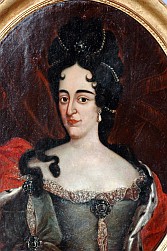Anna Dorothea, Abbess Of Quedlinburg on:
[Wikipedia]
[Google]
[Amazon]
 Duchess Anna Dorothea of Saxe-Weimar (12 November 1657 - 24 June 1704) reigned as
Duchess Anna Dorothea of Saxe-Weimar (12 November 1657 - 24 June 1704) reigned as
 Duchess Anna Dorothea of Saxe-Weimar (12 November 1657 - 24 June 1704) reigned as
Duchess Anna Dorothea of Saxe-Weimar (12 November 1657 - 24 June 1704) reigned as Princess-Abbess of Quedlinburg
This is a list of princess-abbesses of Quedlinburg Abbey.
{{DEFAULTSORT:Quedlinburg, Princess-abbesses
Lists of monarchs
Lists of female office-holders
Lists of clerics
Lists of European people ...
from 1684 until her death.
Born in Weimar
Weimar is a city in the state of Thuringia, Germany. It is located in Central Germany between Erfurt in the west and Jena in the east, approximately southwest of Leipzig, north of Nuremberg and west of Dresden. Together with the neighbouri ...
, Duchess Anna Dorothea was the daughter of John Ernest II, Duke of Saxe-Weimar
John Ernest II (11 September 1627, in Weimar – 15 May 1683, in Weimar), was a duke of Saxe-Weimar. He was the second but eldest surviving son of William, Duke of Saxe-Weimar, and Eleonore Dorothea of Anhalt-Dessau.
Life
After the death of ...
, and Princess Christine Elisabeth of Schleswig-Holstein-Sonderburg
Princess Christine Elisabeth of Schleswig-Holstein-Sonderburg (23 June 1638 – 7 June 1679), was a German noblewoman member of the House of Oldenburg and by marriage Duchess of Saxe-Weimar.
Born in Sonderburg, she was the second of the four ch ...
.
Her father decided she should pursue an ecclesiastical career when she was still a child. From 1681 until 1684, Anna Dorothea was provost of the Quedlinburg monasteries. Upon the death of Princess-Abbess Anna Sophia II, Anna Dorothea was chosen to succeed her, though not without difficulties that required the intervention of the abbey-principality's guardian and fellow Wettin, John George III, Elector of Saxony
Johann George III (20 June 1647 – 12 September 1691) was Elector of Saxony from 1680 to 1691. He belonged to the Albertine line of the House of Wettin.
Early life
Johann Georg III was born in Dresden, the only son of Johann George II and Magd ...
. The Elector consented to her election on 4 September 1684 and Holy Roman Emperor Leopold I
Leopold I (Leopold Ignaz Joseph Balthasar Franz Felician; hu, I. Lipót; 9 June 1640 – 5 May 1705) was Holy Roman Emperor, King of Hungary, Croatia, and Bohemia. The second son of Ferdinand III, Holy Roman Emperor, by his first wife, Maria ...
confirmed it on 29 January 1685.
In 1698, Frederick Augustus I, who had succeeded to the Electorate of Saxony in 1694 and had been elected King of Poland
Poland was ruled at various times either by dukes and princes (10th to 14th centuries) or by kings (11th to 18th centuries). During the latter period, a tradition of free election of monarchs made it a uniquely electable position in Europe (16t ...
in 1697, found himself in need of money as the election had cost him a fortune. The King of Poland therefore decided to sell his rights of guardianship of the abbey-principality to Elector Frederick III of Brandenburg. The change was not welcomed by the citizens of Quedlinburg nor by the Princess-Abbess, as it led to diminishing of her power and loss of many of the abbey-principality's possessions. The Princess-Abbess protested against the sale and refused to recognise the Elector of Brandenburg as the abbey-principality's new guardian until military occupation the same year forced her to do so. As many of her predecessors, she often came into conflicts with the Council of the City of Quedlinburg and her guardian.
Anna Dorothea suffered poor health in 1703 and went to Carlsbad to recover, but without success. She died the next year. She is buried in Weimar.
Bibliography
* Fritsch, Johann Heinrich: ''Geschichte des vormaligen Reichsstifts und der Stadt Quedlinburg''. Quedlinburg 1828 * Lorenz, Hermann: ''Werdegang von Stift und Stadt Quedlinburg''. In: ''Quedlinburgische Geschichte''. Quedlinburg 1922 (Volume 1) {{DEFAULTSORT:Anna Dorothea, Abbess Of Quedlinburg Abbesses of Quedlinburg Lutheran abbesses House of Wettin 1657 births 1704 deaths